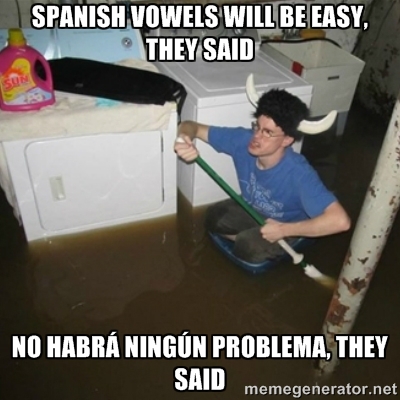Making Spanish Vowels Even Easier with the IPA Posted by Jakob Gibbons on Oct 26, 2015 in Learning, Uncategorized
Are you one of the many language learners who think Spanish only has five simple vowels? It’s true, Spanish has an easy system of pure vowels or monophthongs — a, e, i, o, u — but what about words like rey, aire, or bueno? Spanish vowels are mostly easy, but the diphthongs, vowels made up of multiple sounds, can be a source of frustration and emabrassment for language learners. Regardless of whether you’re just starting out learning or have been speaking for years and want to improve your accent, the International Phonetic Alphabet is the most powerful tool in your linguistic toolkit for learning Spanish speech sounds and perfectly pronouncing those Spanish vowels.
If you want to learn about vowels like a linguist, check out my post on the Language News blog about IPA for learning vowel sounds for a more detailed look. But if you’re just in it for the tacos and margaritas, this post should do the trick.
Vowels are a bit more difficult to pin down than their highly-structured consonant cousins. Part of the definition of a vowel is that they’re made with an open mouth, which makes them sort of vague mushy sounds to start with. Instead of talking about the moving parts or articulators in the mouth like we did with consonants, now our eyes and mouths are on the position of the tongue in the vocal tract.
When you learned in Spanish class that there are only five vowels or vocales, that was partly true. There are indeed five monoptongos or pure vowels, and they’re the usual suspects. However, when two of these sounds come together, the whole is greater than the sum of its parts, resulting in a more complex diphthong or diptongo made up of two pure vowels.
This is where the IPA vowel chart can help you: this abstract map of your mouth shows you where the highest point of the tongue goes to make any given vowel sound. Linguistically transcribed between /slashes/ to represent the sound instead of the letter, /i/ is produced high in the front of your mouth, and /u/ is high in the back. Fun fact: this is why the doctor tells you to say “aaaahh”, because producing this /a/ sound pushes your tongue forwards and down, letting Doc get a good look at your pipes.
Let’s take the word rey, meaning ‘king’, as an example of a Spanish diphthong. How would you pronounce this? Many native English speakers and others around the world would pronounce it something like /re/, using the flat vowel /e/ heard in Spanish words like quedar, ella, or eso, but that’s only getting halfway there. The second half is the vowel /i/, like in sin, ir, or vida.
To fully pronounce rey, the tongue has to start in the position of /e/ and move up in the front of the mouth to the high point of /i/. It’s the same phenomenon that takes place every time you refer to yourself with the word ‘I’ in English: your tongue starts low at /a/ and smoothly slide up to /i/ in the top front of the mouth. Native speakers won’t even notice the motion, which is why these sounds come out so smoothly.
But what does it mean for a sound to move or slide into another one?
Say the English word ‘I’ a few times and focus on how your tongue feels. Then try a word with a pure vowel, like ‘eat’. In the first example, you should feel your tongue gracefully doing the wave in your vocal cavity: it’s not an abrupt or jerking motion, but more of a sliding transition. The vowel in ‘eat’, in contrast, stays put. Your tongue doesn’t move until it’s ready to finish off the word with a /t/.
The same thing happens in Spanish, and it’s notorious for tripping up language learners (and often the source of a little teasing from natives). The first part of this video is about Spanish diphthongs, and it’s spoken in articulate Spanish at a reasonable speed that most learners should be able to understand. Give it a quick look and practice some of your Spanish diphthongs along with it:
As you see in the video, we have the same kinds of moving vowel sounds in Spanish words like rey or bueno. If you isolate the vowels in either word, you should feel your tongue undulating: rey starts in the middle-front part of the mouth, then climbs up to /i/. Bueno starts high in the back of the mouth at /u/ then gracefully sweeps down to /e/ in the front. Can you feel your tongue moving when you say these words?
There’s a learning curve to figuring out all the IPA symbols and what they represent, but one solid afternoon spent on the beautifully thorough Wikipedia page on the IPA vowel chart should do the trick. A priceless added bonus is the IPA vowel chart with audio, where you can click and listen to sounds to see if you’re pronouncing them correctly.
So check out the super useful resources at Wikipedia, review our original post on using the IPA for learning vowel sounds, and start practicing! With a little studying you should have no problem visiting Buenos Aires and impressing the locals with your flawless pronunciation of the two tricky diphthongs in its name!

Build vocabulary, practice pronunciation, and more with Transparent Language Online. Available anytime, anywhere, on any device.





